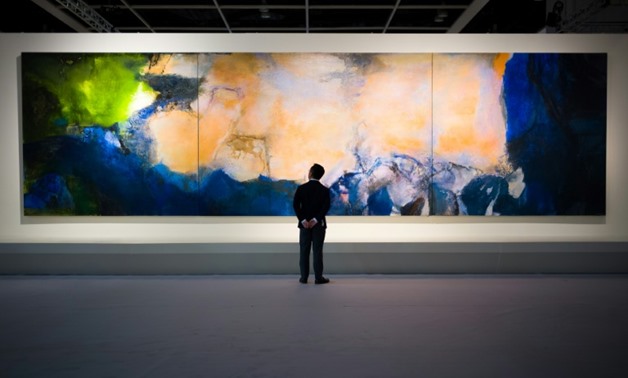
A man poses in front of 'Juin-Octobre 1985' by Chinese painter Zao Wou-Ki at Sothebys auction house showroom in Hong Kong on September 26.
The contemporary art market is booming with Chinese artists helping to push prices up by nearly a fifth in the past year, the world's biggest art index said Monday.
Rocketing prices for living artists have for the first time become the motor of the market, Artprice told AFP.
Nowhere is the trend more marked than in the Chinese-speaking world, with works sold in China, Hong Kong and Taiwan accounting for more than a quarter of the global total.
The record price for an Asian artist was smashed Sunday when the late Zao Wou-Ki's huge abstract triptych "Juin-Octobre 1985" went under the hammer for $65 million (56 million euros) in Hong Kong.
The sum is nearly three times the previous record, also held for a Zao, set only nine months ago for another of his masterpieces, "29.01.64".
Painters like Zhang Xiaogang, Zeng Franzhi and Chen Yifei -- one of whose hyper realistic depictions of melancholic women in traditional dress sold for $22.7 million in December -- are leading a new wave of Chinese art superstars.
"In China one million contemporary artists are living from their work," said Artprice founder Thierry Ehrmann.
"They are coming to dominate the market because of their number, the quality of their work and their sharp critical sense," he added, with sales from China and Taiwan nearing half a billion dollars.
- $110m record for a Basquiat -
Ehrmann had earlier predicted that the art market was entering a "new era of prosperity" thanks to the thirst for modern and contemporary work.
The $110.5 million paid for a painting by the black American artist Jean-Michel Basquiat in May was no flash in the pan, he told AFP.
Basquiat, who began as a graffiti artist and died at 27 from a heroin overdose, is now the sixth most expensive artist ever.
A street was named after him in Paris this weekend ahead of a major retrospective of his work at the Vuitton Foundation in the French capital.
The New Yorker heads the list of the year's top selling contemporary artists with $256 million of sales ahead of the Scot Peter Doig ($101 million) and Italian painter and installation artist Rudolf Stingel ($52 millions).
Ehrmann said that "contemporary art, with postwar art, is the only really performing period" right now although they account between them for only a third of all sales.
"Artists are having works coming up for auction at the age of 25 or 30. That would have been impossible before," he added.
- 'Profound change' -
The stratospheric prices paid for Basquiat "illustrates a profound change in market attitudes", Artprice reported, showing that "collectors are now perfectly willing to pay equivalent sums for contemporary and historical masterpieces alike."
The burgeoning contemporary market, however, is dominated by some 500 artists who between them account for 89 percent of global sales, the index revealed in its annual report.
Artprice also found that the average price of contemporary drawings, paintings, sculptures, videos and installations has more than quadrupled from the turn of the millennium to $28,000.
Demand for contemporary work was traditionally the weakest part of the art market, but its share has risen five-fold since 2000, it added.
Ehrmann argued that its success is partly because artists have "come back down to earth, and are engaged with their times... Like in during the 1960s, artists are taking positions on society."
He said that artists and their galleries have also become streetwise, "limiting their production" and what comes to market so as not to undermine their prices.
With museums becoming "the cathedrals of the 21st century where people try to find the sacred in a society which has lost it," art's attraction is undimmed, the expert insisted.
Three auction houses dominate the contemporary market, the report found -- Sotheby's (28 percent), Christie's (26 percent) and Phillips (15 percent). However, six of the ten biggest players in the world are now Chinese.
Modern art made up for nearly half of auction sales over the last 12 months, Artprice said, followed by postwar art (21 percent), contemporary (12 percent), with Old Masters and 19th-century art accounting for some 10 percent each.


Comments
Leave a Comment